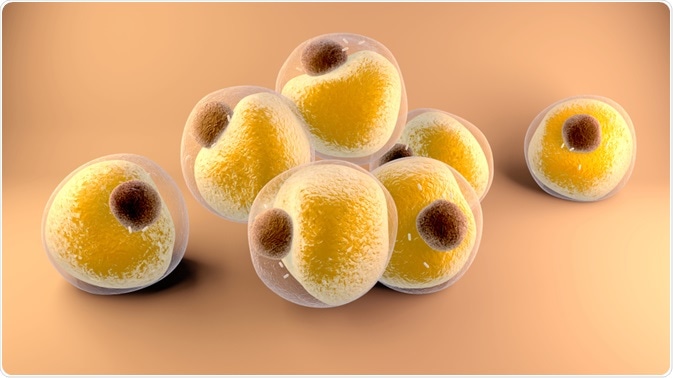With obesity rates rising worldwide, there is a growing interest in understanding the formation and regulation of fat cells, or adipocytes, and how an increase in their number leads to disease.
 Design_Cells | Shutterstock
Design_Cells | Shutterstock
Types of adipocytes
Adipocytes can be classified into three types; white, brown and beige.
White adipocytes
White adipocytes are unilocular, or single-cavity fat droplets. They are involved in storing fat, producing hormones that regulate nutrient homeostasis, food intake, inflammation, cardiovascular activity, and regeneration of tissues. They are organized into distinct depots that are present in widespread locations in the body.
Brown adipocytes
Brown adipocytes are multi-locular, or multiple-cavity fat droplets. They are involved in adaptive thermogenesis, which refers to energy expenditure under conditions of specific physical activity and energy intake. They also regulate nutrient homeostasis. They are organized as distinct depots in the interscapular region in infants, and in the cervical, supraclavicular, and paravertebral regions in adults.
Beige adipocytes
Beige adipocytes are also multi-locular or multiple-cavity fat droplets and are involved in adaptive thermogenesis and nutrient homeostasis. They are interspersed among the brown and white adipocyte in the cervical, supraclavicular, axillary, and paravertebral regions in humans.
What are the functions of adipocytes?
There are three main functions of adipocytes; storing energy, releasing hormones and producing heat.
Storage and release of energy
White adipocytes are specialized fat-storing cells that can accumulate lipids. Their primary function is to act as an energy bank. In cases where there is excess energy, free fatty acids are generated during hydrolysis of triglyceride-rich lipoproteins and chylomicrons and become stored in white adipocytes. Lipids can also be synthesized from carbohydrates using de-novo lipogenesis. During low energy levels, adipocytes can break down triglycerides and release free fatty acids, which can be burned for energy.
Endocrine functions
Although adipocytes have been known for their capacity to store energy, they are also capable of producing hormones to influence energy intake. Leptin, for example, is a central hormone that regulates satiety, and is is produced and secreted by adipocytes.
Following a study which introduced the role of adipocytes in endocrine functions, many adipocyte hormones, such as adiponectin and adipson have been discovered. Other studies have found that during obesity, adipose tissue can also produce a pro-inflammatory cytokine that can drive insulin resistance.
Thermogenic functions
Apart from energy-storing functions and balancing energy intake, there is an additional type of adipocyte that is present in mammals that serves to convert chemical energy to heat. These are called "brown adipocytes", as their mitochondria gives these cells a brown color.
As brown adipocytes were historically present in animals to protect them against cold, they were referred to as the "hibernating organ". These brown adipocytes, now called “beige adipocytes”, function in response to cold, exercise, and also in pathological conditions.
Role of adipocytes in disease
Cardiometabolic diseases
Although obesity is a risk factor for developing metabolic disorders, almost one-third of obese individuals are resistant to developing metabolic syndrome. Thus, factors other than adipocytes may be involved in metabolic health during obesity.
The expansion of fat mass can be due to an increase in triglyceride storage in adipocytes, or an increase in the number ofadipocytes. Studies show that healthy adipocytes can act as a ‘lipid sink’ and protect against metabolic diseases and cardiac dysfunction.
Cancer
There is increasing evidence that increased adiposity is associated with an increased incidence, morbidity, and mortality associated with cancer. The precise mechanism of the link between obesity and cancer remains unclear. There is also evidence that adipose tissue and adipose tissue microenvironment can directly regulate tumor cells and their growth.
Adipokines, such as leptin and adiponectin have been implicated in ovarian, breast, colon, and other types of cancer. On the other side of the picture, the tumor tissue can also have an effect on the function of adipose tissue. For example, many cancer patients suffer from cachexia, which is a condition associated with loss of muscle and fat.
Further Reading
Last Updated: Apr 1, 2019